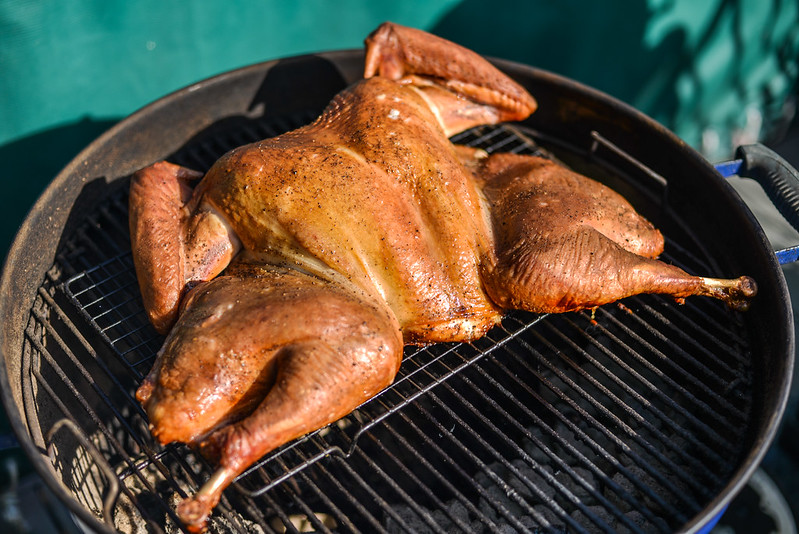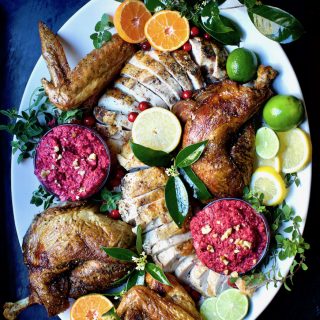As Thanksgiving and Christmas approach, home cooks everywhere are gearing up to prepare the star of many holiday meals – turkey! While roasting a whole turkey is traditional, spatchcocking (or butterflying) the bird has become a popular cooking method. Spatchcocking removes the backbone and flattens the turkey so it cooks more evenly. This leads to a common question – should you spatchcock a turkey before brining it?
There are good arguments on both sides of this debate Here are the key factors to consider when deciding if spatchcocking should come before or after brining your holiday bird
What is Spatchcocking?
First, let’s review what spatchcocking entails To spatchcock a turkey
- Place the turkey breast side down on a work surface. Using sturdy kitchen shears, cut along both sides of the backbone to remove it.
- Flip the turkey over and press down firmly on the breastbone to flatten the bird. You can also crack the breastbone to make it lay fully flat.
- The turkey is now spatchcocked! The flatter shape allows for more even roasting.
Benefits of Spatchcocking Before Brining
There are some advantages to spatchcocking your turkey before letting it soak in a brine.
Enhanced flavor penetration
Brine diffuses into meat through the process of osmosis. Spatchcocking speeds this up by creating more surface area for the brine to permeate into the turkey breast and thighs. This can lead to more well-seasoned meat.
Shorter brining time
Thanks to improved brine absorption, a spatchcocked turkey may only need a 6-12 hour brine instead of a full 24 hours for a whole turkey.
More even cooking
Spatchcocking promotes air flow and exposes more of the bird directly to the oven’s heat. This helps the white and dark meat cook at the same rate.
Faster roasting
With a flattened shape and increased moisture, a spatchcocked turkey can cook 25-50% faster than an intact turkey. This saves time on Thanksgiving when oven space is prime real estate.
Better crisping
The flattened bird has more skin surface in contact with the roasting pan, leading to extra crispy skin as it cooks.
Drawbacks of Spatchcocking First
However, there are a few potential cons to spatchcocking before brining that you should be aware of.
Messy process
It can get messy removing the backbone over a bowl of brine solution, and you have to rinse the bird after. Opting to spatchcock after brining keeps the process neater.
Might absorb too much salt
Since spatchcocking opens up the turkey, it could lead to over-salting if your brine is especially salty and left to soak too long.
Difficult to stuff
Spatchcocking makes it tricky to stuff the turkey cavity since the bird lays flat. If a stuffed turkey is important to your holiday meal, spatchcocking second may work better.
Need extra oven space
The flattened shape takes up more surface area in your oven. For large gatherings, you may need to roast multiple spatchcocked birds instead of one big turkey.
Can dry out breast meat
With the breast exposed, some cooks find the lighter meat dries out quicker in a spatchcocked turkey. Tenting with foil while roasting helps prevent this.
Frequently Asked Questions
Still unsure which order is best for your needs? Here are answers to some common questions about spatchcocking and brining turkeys.
How long should I brine a spatchcocked turkey?
8-12 hours is usually sufficient brining time for a spatchcocked bird. Whole turkeys brine for 12-24 hours.
Should I rinse off the brine before roasting?
Pat the turkey dry after brining, but avoid rinsing since it can wash away flavorful spices and herbs from the brine.
Can I stuff a spatchcocked turkey?
Stuffing a spatchcocked bird is very challenging. It’s best to cook stuffing in a casserole dish alongside the flattened turkey.
What’s the best roasting method for spatchcocked turkey?
Roasting on a rack in a sheet pan works well, as does spatchcocking directly on the pan. The rack improves air flow for crisper skin.
How long does it take to roast a spatchcocked turkey?
Cook times range from 1-1.5 hours for a 12 lb spatchcocked turkey roasted at 400°F. Larger birds take only slightly longer.
What size turkey is best for spatchcocking?
The technique works great for turkeys from 8 lbs to over 20 lbs. Flattening smaller birds makes them cook more evenly.
Can I still make gravy from a spatchcocked turkey?
Yes, you can still make delicious gravy. Use the drippings from the sheet pan after roasting.
The Verdict
After weighing the pros and cons, my recommendation is to brine the turkey first, then spatchcock it. While spatchcocking first does allow for faster brining, most brine recipes already rapidly penetrate into poultry within 12-24 hours. Removing the backbone and flattening the bird after brining helps keep the process tidier. It also reduces the risk of over-salting.

Turkey Dry Brine Recipe
- 1/2 cup Kosher salt
- 1/4 cup brown sugar
- 2 sprigs fresh rosemary minced
- 3 Tablespoons garlic powder
- In a medium-sized bowl, mix salt, brown sugar, rosemary, and garlic powder until fully incorporated. Place turkey on a roasting rack inside a large roasting pan. Pat mixture all over the entire surface area of the turkey, inside and out. Chill in the refrigerator uncovered (air needs to surround the turkey) for 48 hours.
- About 1 hour before you will be cooking the turkey, remove turkey from refrigerator and rinse thoroughly. Pat turkey until completely dry. Allow to come to room temperature before you cook the bird. It will cook more evenly and more quickly.
- Your turkey has been brined and is now ready to fry, roast, or smoke!
If you like this recipe, please give it a star rating to help other cooks find it!
Fresh Garlic or Garlic Powder?
I’m a huge believer in using fresh garlic, but I make an exception for dry brines. I find that incorporating garlic powder with the other dry brining ingredients not only is convenient but tastes better. The garlic powder adds “just enough” flavor to the meat without overpowering it.
Slate.com states my exact sentiment with much more finesse: “but garlic powder acts like glue behind glitter, adding a subtle fullness of flavor that may be more difficult to detect, but nonetheless makes the meal taste better.” How to Roast a Perfect Turkey
Now you’re ready to cook your turkey!
Problem: Turkeys take such a long time to cook.
Solution: Spatchcocking is a way to get a turkey on the table fast.
Spatchcocking is really just a fancy term for removing the backbone from the bird before you roast it. Spatchcocked turkeys take less time to cook and also tend to cook more evenly than a whole roast turkey.
Other than when I fry a turkey whole, I prefer to spatchcock my turkey for more even cooking and crispier skin. If I wet brine the turkey, then I do the brining first. (You can reverse the steps if you’re doing a dry brine.)
Below is my Roast Spatchcocked Turkey Recipe.
Note: Don’t discard the backbone. It’s perfect for making a deep flavored broth!
Tip #1: Begin checking the turkey for doneness about 20 minutes after you reduce the temperature to 350 degrees. Check the temperature every 15 minutes ensuring you do not overcook the turkey.
Tip #2: Don’t forget to allow the turkey to rest for at least 30 minutes on a cutting board before cutting. During this resting time, carry-over cooking will occur and the juices will redistribute, making a juicy bird.

How to Brine a Turkey: Two Methods
Brining ensures moisture will be retained in the meat during the cooking process. There are two types of brine; a wet brine and a dry brine. Salt is the key component to both.
A wet brine is simply a mixture of salt, water, and spices used to season and retain moisture in meats. Along with the salt, the water gets absorbed at the cellular level into the bird. This ensures a moist turkey on the table.
I enjoy a lightly flavored brine that enhances the turkey’s flavor, especially if cooking a wild turkey. In addition to salt, I find that acid assists in poultry prep by aiding in the breaking down of muscle fiber and connective tissue to further enhance tenderness and flavor. I also add sugar to balance the saltiness and sourness. To me, it’s a perfect balance.
Prepare the brine to your favorite flavor profile; just be sure to have at least an 8% salt to water by weight to ensure the retention of water during cooking.
Problem: Wet brining a whole turkey can prove troublesome because the bird has to stay completely submerged in the brining solution. You may not have enough room in your refrigerator to keep the turkey and brine cold for the entire brining process. Brining Turkey is simple using a cooler and a trash bag!
Solution: Place the brine in a trash bag inside a cooler. By periodically pouring ice into the bag, you can ensure that your turkey will remain at a safe temperature (between 35 and 40 degrees F).
Tip: To keep the brine from getting too diluted, you can wrap the bag around the turkey and pour ice over the bag.
Timing: I brine my turkey for 24 to 48 hours.
When you are ready to cook the turkey, remove it from the brine and then rinse and dry it very well.
Watch me demonstrate how to wet brine a turkey for the Outdoor Channel:

